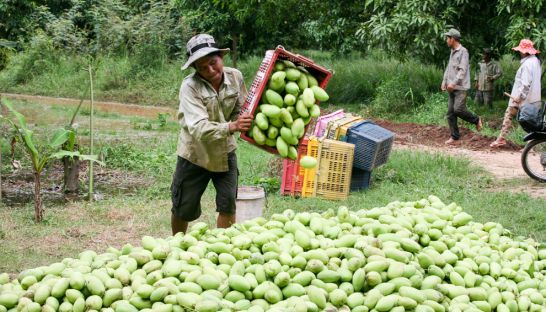Mango producers struggle to meet Korean standards
Mango producers struggle to meet Korean standards
It has been nearly a year since the government signed a memorandum of understanding with South Korea that aimed to put Cambodian mangoes on the shelves of supermarkets in Seoul, yet local producers say there is little sign of any movement.

According to In Chayvan, president of the Kampong Speu Mango Association, the potentially lucrative trade agreement signed last December has stalled on South Korea’s stringent sanitary and phytosanitary (SPS) regulations, which local producers are unable to comply with.
“Firstly, we are farmers, so we were happy to hear that the government had inked this agreement, but when we later found out about South Korea’s requirements, we lost hope,” he said yesterday.
“South Korea is focused on food safety, which is the main barrier for us as we cannot afford the technology required to kill all the bacteria on our mangoes,” he explained.
According to Chayvan, Cambodia’s top-tiered keo romeat mangoes currently fetch between 1,000 and 2,000 riel per kilo here, but could sell for considerably more if shipped to South Korea. Yet it could be several years before Cambodia has a processing plant that can treat the mangoes with heated water, bringing bacteria counts to within acceptable levels.
Chayvan said Cambodian mango growers would be better off focusing their efforts on securing export contracts for China, and upping shipments to the Thai and Vietnamese markets. He said these countries have less stringent SPS regulations, while Thailand and Vietnam are ready to bend the rules on SPS and certificates of origin when their domestic production is insufficient to meet demand.
Cambodian farmers have cultivated mangoes on nearly 100,000 hectares, with a dry season harvest taking place in March and April, and a smaller rainy season harvest in October and November. Over 9,000 tonnes of mangoes were exported in 2015, the majority shipped to Vietnam.
According to Chayvan, many of the mangoes sent to Vietnam are re-exported to China and other markets.
Ker Monthivuth, director of the plant protection and SPS department at the Ministry of Agriculture, said the ministry was working to fulfil South Korea’s requirements and was currently seeking investment to build a mango treatment facility.
“We hope that exports to South Korea will begin next year as we have met with Korean investors who said they are happy with our mangoes’ quality and taste, and are ready to build a treatment plant that will sterilise the fruit.”
He said once in compliance with Korean SPS requirements, Cambodian keo romeat mangoes could fetch at least 4,000 riel ($1) per kilo from South Korean buyers.
Monthivuth added that the Ministry of Agriculture was currently looking to sign a memorandum of understanding with China to export mangoes to its market.
“Cambodian mangoes have high potential for cultivation as our varieties have high quality and taste compared to those of neighbouring countries,” he said. “We are looking to bring in new technologies and expand export markets for farmers.”
Mong Reththy, chairman of the agro-industrial conglomerate Mong Reththy Group, said his company has already shipped mangoes to Europe this year, and was looking forward to the possibility of exporting them to South Korea.
However, he said, the Koreans take food safety very seriously and this has proven a stumbling block.
“We are always looking to export to South Korea, but the issue is whether or not the government could meet their requirements,” he said.













